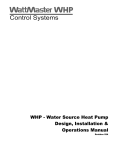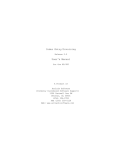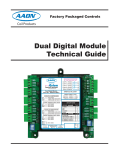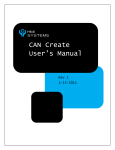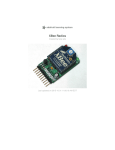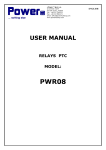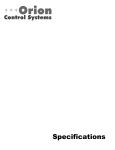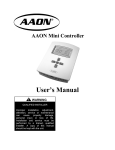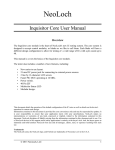Download Air Live WHP-1100 Technical data
Transcript
GPC Plus Controller General Information & Application Guide OE331-21-GPC Plus GPC Plus Controller .20 Dia. Typ. of 4 D1 6.2“ CX1 RN1 1 CX3 U3 C21 CX2 U2 U1 CX4 RLY1 U4 V1 D2 TB1 COMM V2 T SHLD RLY2 V3 U5 PAL RS-485 RLY3 RN3 HH (1 MEG) YS101816 REV. 2 U6 D4 LD8 LED1 TUC-5R PLUS RN2 1 +VREF C2 V4 D14 R10 D13 JP1 R11 D12 R13 SC1 U13 R15 U12 CX14 C14 R19 C16 U14 CX13 TB4 C15 D19 GND D16 R22 C19 D18 C18 PJ3 PJ2 EXPANSION 7824CT R26 R25 CX15 D17 R24 C20 R27 U15 V6 D15 PJ1 PRESSURE SENSOR U11 C11 X2 C9 CX12 C13 C12 AOUT2 AIN7 GND C17 CX8 R6 L1 D11 PU7 NE5090NPB3192 0PS C7 U10 SW1 D9 PU5 0-1 VDC GND C10 GND AOUT1 U9 CX10 D10 D7 PU3 AIN5 6.6” U8 1 2 4 8 16 32 TOKEN NETWORK PU1 D6 PU2 D8 PU4 1 ADD RN5 0-5 VDC AIN1 AIN2 AIN3 AIN4 R7 ADDRESS +VDC RN4 INPUTS RLY5 V5 C3 R28 X1 PHILIPS EWDOG TB2 D5 CX6 5.11V TEST POINT RV1 VREF ADJ COM4-5 RLY4 P1 R1 TB3 R4 R5 C1 LD9 LED2 U7 R1 R2 R3 1 EPROM RAM COMM LD7 PWR POWER COMM 7.3” COM1-3 D3 RCX5 LD6 24VAC M The OE331-21 General Purpose Controller Plus (GPC Plus) is used for controlling equipment or processes that cannot be controlled using HVAC controllers. The Prism computer front end software is used to interface with the GPC Plus controller functions. The GPC Plus Controller provides the flexibility to control, schedule and/or monitor equipment such as unit heaters, exhaust fans, motorized louvers, etc.. The GPC Plus has (6) configurable inputs which will accept signals from thermistor temperature sensors, 4-20mA or 0-5VDC transmitters or dry contact closures. An additional modular input is provided for connection of an OE271 static pressure sensor. The GPC Plus has (5) relay outputs for on/off control and (2) analog outputs. With the addition of the OE352 2 Slot Expansion Base Board and (1) OE357 4 Relay Expansion Board, (4) additional relay outputs are available providing for a maximum of (9) usable relay outputs. The GPC Plus also has (5) separate 2 event per day schedules, each with its own optimal start functions built in. In addition the GPC Plus provides lead/lag start capabilities. MC34064A 9936 Description T'STAT VR1 VR2 6.7” 1.1” Mounting The GPC Plus is provided with an integral backplate for mounting inside of a control enclosure. It is recommended that the GPC Plus be mounted in the HVAC unit control enclosure, or in a control enclosure in the building equipment room. An optional factory control enclosure for the GPC Plus is available. Technical Data OE331-21-GPCPLUS GPC Plus Controller Power Power Consumption Operating Temp 24 Volt AC 8 VA Maximum 10°F to 149°F 90% RH Non-Condensing Operating Humidity Weight Network Connection Protocol Communications Inputs: Types of Allowed Inputs Total Inputs Available Static Pressure Inputs Configurable Inputs Schedules Available Type III-10kohm sensors 4-20ma sensors N.O. Binary Contact N.C. Binary Contact 7 1 (Modular ) 6 (5) 2 Event per day Three Year Warranty Form: WHP-OE331-21-GPCPlusController-01A.doc 1.5 lb. RS-485 HSI Open Protocol Token Passing RS-485 - 9600 Baud Outputs: Total Relay Qty. On Board Total Relay Qty. Available With Optional Expansion Board Relay Power Rating Analog Output Qty. Analog Output Signal Optimal Start Schedules Lead Lag Scheduling 5 9 (2 Amp @ 24 VAC) 2 0-10 VDC (5) Total - (1) for Each Schedule (1) Output can be Configured WattMaster reserves the right to change specifications without notice Page 1 of 1 C21 U3 CX1 CX2 U1 CX4 RLY1 U4 V1 D2 TB1 COMM V2 T SHLD RLY2 U5 PAL RS-485 COMM RAM RLY3 RN3 HH (1 MEG) YS101816 REV. 2 U6 D4 LD8 LED1 TUC-5R PLUS RN2 1 COM4-5 RLY4 P1 +VREF TB2 D5 CX6 5.11V C2 C3 R28 1 INPUTS ADD ADDRESS CX8 C7 R6 D14 X2 CX12 D12 R13 JP1 C9 R11 0-5 VDC 0-1 VDC D11 PU7 C11 L1 SC1 U11 SW1 R10 U10 D9 PU5 C13 C12 U13 R15 U12 CX14 C14 R19 C16 U14 CX13 D15 U15 TB4 C15 PJ1 D19 GND EXPANSION V6 D16 C19 C18 D18 GND Line Voltage 24VAC 24VAC Transformer 10 VA Mini mum 24VAC PJ3 PJ2 R26 PRESSURE SENSOR R25 CX15 D17 R24 C20 R27 R22 POWER AOUT2 AIN7 GND C17 TB3 U9 CX10 D13 D8 PU4 NE5090NPB3192 0PS R7 D7 PU3 D10 PU1 D6 PU2 AIN5 Note: When Using Sensors or Transducers With 4-20 mA Input Signal, The Pull-up Resistor For The Input Being Used Must Be Removed From The Controller Board And A 250 Ohm Resistor Must Be Wired Between The Input Terminal And The Ground Terminal On The Controller Board 1 2 4 8 16 32 TOKEN NETWORK RN5 GND C10 GND AOUT1 RN4 U8 +VDC AIN1 AIN2 AIN3 AIN4 V5 RLY5 EWDOG RV1 VREF ADJ V4 X1 Analog Inputs AIN1Thru AIN7 Can Be Used For 10kOhm Type III Thermistor, 0-5VDC Signal, 4-20mA Signal Or Dry Contact Closure Inputs. As Required. TEST POINT PHILIPS U7 R4 R5 C1 R1 5 Relay Outputs Are Available On Board For On/Off Control Of Equipment. When Required 4 Additional Relay Outputs Are Available By Using The Optional OE357 4 Relay Output Expansion Board. See Below. R1 R2 R3 1 EPROM COMM LD7 PWR LD9 LED2 Pull-up Resistor- Typical COM1-3 D3 RCX5 LD6 Mini DIN Connector For Connection Of Modular Service Tool 24VAC Power For Relay Outputs V3 MC34064A 9936 Connect To Next Device On The Local Loop Local Loop RS-485 9600 Baud U2 RN1 1 CX3 T To T, R To R, SHLD To SHLD D1 OE331-21-GPCPLUS GPC Plus Controller All Communication Loop Wiring Is Straight Through T'STAT VR1 VR2 Not Used Splice If Req’d Connect To Expansion Board Base (When Used) GND PJ1 PJ2 +24VDC-OUT GND LD1 PWR 24VAC-IN U1 OMRON 74HC04N G5L-114P-PS 24VDC CONTACT: UL 5A250VAC YS101790 K4 OMRON PCF8574P CX3 R14 D3 G5L-114P-PS 24VDC CONTACT: UL 5A250VAC OMRON LM358N G5L-114P-PS 24VDC CONTACT: UL 5A250VAC OMRON C4 VR6 P2 MC 7812CT OE357 4 Relay Output Board U3 C3 VR5 MC 7824CT U2 U2 VR4 MC 7824CT CX2 K3 RN1 K3 K4 4RLY IO BD. P1 CX1 K2 K1 K1 K2 V4 CX2 C5 4 Additional Relay Outputs Are Available By Using The OE357 4 Relay Output Expansion Board. The OE352 2 Slot Expansion Base Board Is also Required To Mount The OE357 Board. V1 TB1 Connect Tubing To High Pressure Port (Bottom Tube) and Route To Static Pressure Pickup Probe Located In Unit Discharge. Leave Port Marked “Lo” Open To Atmosphere TB1 TB2 S.P. Transducer C6 24 VAC Must Be Connected So That All Ground Wires Remain Common. Failure To Do So Will Result In Damage To The Controller G5L-114P-PS 24VDC CONTACT: UL 5A250VAC Warning: ULN2803A/ Analog Input AIN6 Can Only Be Used For Connection Of A Static Pressure Transducer With Modular Connector JP2 R10 VR1 2 SLOT MODULAR I/O YS101780 R6 R5 R4 R12 Jumper Setting OE352 2 Slot Expansion Base Board 1.)24 VAC Must Be Connected So That All Ground Wires Remain Common. 2.)All Wiring To Be In Accordance With Local And National Electrical Codes and Specifications. JOB NAME 3.)All Communication Wiring To Be 18 Ga. Minimum, 2 Conductor Twisted Pair With Shield. Belden #82760 Or Equivalent. 4.)It Is Recommended That All Controllers Address Switches Are Set Before Installation. FILENAME G-GPC-PlusCNTRL1A.CDR DATE: 03/08/05 PAGE 1 Of 2 DRAWN BY: B. Crews DESCRIPTION: OE331-21-GPCPLUS GPC Plus Controller This Switch Should Be In The OFF Position As Shown ADDRESS ADD Note: The Power To The Controller Must Be Removed And Reconnected After Changing The Address Switch Settings In Order For Any Changes To Take Effect. S S ES R D AD ES R D AD 1 2 4 8 16 32 TOKEN NETWORK D AD D AD Caution Disconnect All Communication Loop Wiring From The Controller Before Removing Power From The Controller. Reconnect Power And Then Reconnect Communication Loop Wiring. Controller Address Switch Address Switch Shown Is Set For Address 1 Address Switch Shown Is Set For Address 13 The Address For Each Controller Must Be Unique To The Other Controllers On The Local Loop. For Auto-Zone Systems The Address Must Be Set Between 18 to 30 For All Other Systems The Address Can Be Set Between 1 to 59 INPUTS ADD ADDRESS +VDC 2 CX10 C7 R6 SW1 D9 PU5 D14 D12 R13 JP1 SC1 C13 U13 R15 U12 CX14 C14 R19 C16 U14 CX13 TB4 C15 D19 GND D16 R22 V6 D18 C19 24VAC PJ3 PJ2 PRESSURE SENSOR EXPANSION C18 R25 CX15 D17 R24 C20 POWER U15 PJ1 R27 D15 R26 C9 R11 X2 C11 0-1 VDC D11 PU7 GND C10 GND AOUT1 C12 AOUT2 AIN7 GND C17 L1 CX12 U11 U10 R10 TOKEN NETWORK D13 32 R7 D7 PU3 D10 4 8 16 D8 PU4 AIN5 TB3 PU1 D6 PU2 0-5 VDC AIN1 AIN2 AIN3 AIN4 1 RN5 VR1 VR2 JOB NAME FILENAME 1.)24 VAC Must Be Connected So That All Ground Wires Remain Common. 2.)All Wiring To Be In Accordance With Local And National Electrical Codes and Specifications. 3.)All Communication Wiring To Be 18 Ga. Minimum, 2 Conductor Twisted Pair With Shield. Belden #82760 Or Equivalent. 4.)It Is Recommended That All Controllers Address Switches Are Set Before Installation. G-GPC-PlusCNTRL1A.CDR DATE: 03/08/05 PAGE 2 Of 2 DRAWN BY: B. Crews DESCRIPTION: OE331-21-GPCPLUS GPC Plus Controller General Purpose Controller (GPCPlus ) January 31, 2005 Description The GPCPlus is a controller designed to “fill in the blanks” between standard off the shelf programs and minor non-standard applications. An example of a non-standard application might be exhaust fan control, based on building pressure or a simple boiler enable controller based on schedules or outdoor air temperature. The remainder of this document will describe the I/O configurations that are possible and will also include a few sample applications to aid the user in determining if this controller will meet their specific requirements. Main Status Screen The Main Status Screen provides real-time live updates of the current operating conditions and is used to access the various setpoint and configuration options. No control takes place until the user “configures” the operation of the GPCPlus. Access to the various configuration screens is made by a simple left mouse-click on the individual reading or output status box for each I/O Point. As a general rule, a left click 1 accesses the configuration for the selected item and a right click accesses the force mode options if any are available. Analog Inputs Relays Analog Outputs 2 Week Schedules & Holidays 3 Analog Input Configurations The first five analog inputs and input #7 can be configured in several different ways. Input #6 can be used for Static Pressure and accepts the standard pressure sensor with the phone jack connector, available from WattMaster Controls. The following configurations are available: 1. 2. 3. 4. 5. 6. 7. Thermister Type III Temperature Sensors (Scaled for Fahrenheit) Thermister Type III Temperature Sensors (Scaled for Celsius) 4 – 20ma User Scaled 0 – 5 vdc User Scaled Wall Sensor Slide Offset Binary Contact Closure Read Global Analog Broadcast from another Controller 4 8. Read Global Binary Broadcast from another Controller 9. Sensor #6 can be assigned to read Static Pressure Each input is separately configured so combinations of any type of input on the same controller are possible. All readings can be overridden to specific values for test purposes. All thermister sensors can also be calibrated by entering positive or negative offsets to be applied to the current readings. All 4 – 20ma readings can be calibrated if the user has the exact current or resistance values available for entering in the calibration fields. Right-Click on the desired analog input reading to access the pop-up menu shown above and then select the desired function. If you are calibrating or overriding the reading, the following window will pop-up. Enter the desired calibration offset or specific reading you wish to force the input to and press the Enter key. The window will automatically close and send the command to the controller. If you select the Clear Sensor Override option, a window will not appear but the clear command will be sent to the controller. - OR - 5 Any or all readings can also be “broadcast” to other controllers on the communications loop. For example, the Outdoor Air Temperature is broadcast on channel #2 by any unit that happens to have the sensor attached. If none of the standard package units have the outdoor air sensor attached, you could attach it to the GPCPlus and select it for broadcast on channel #2. All other controllers would “hear” the broadcast and use it in their normal operations. On the other hand, if you are measuring something like return air humidity, do NOT select channel #2 to broadcast it on, since all the package unit controls are expecting the outdoor air temperature. If no package controllers exist on your system then you are free to use any available global channel for broadcast. There are 32 possible global analog channels and 16 possible global binary channels. Select global analogs to broadcast readings and global binary channels to broadcast contact closure (on/off) information. If you select one of the unassigned channels for broadcast, it is assumed that you have other GPCPlus units installed that expect to receive information on those channels since the standard package code does not listen for broadcasts on unassigned channels. CAUTION: If you elect to broadcast a reading from the GPCPlus to all other controllers on your installation, be sure to check the HELP screen to identify which Global Channels have already been assigned. Each input also provides high and low alarm limits if the user requires out of range values to notify service personnel. The alarm limits can be widened at night and they can also be forced to be out of limits for a user defined amount of time before an alarm occurs. This prevents false alarms if the reading temporarily exceeds the limit but then recovers and stays within the limits the remainder of the time. All readings are user scalable. That means you can display values with ± 1, ± 0.1, ± 0.1± 0.01 or higher resolutions. Just keep in mind that the maximum value that can be sent from the controller is ±30,000 so if you have scaled your reading to ± 0.001 then the maximum value you can send is ± 30 with the 3 additional decimal values (30.000). 6 Each input can also have an appendix selected to display with the reading to make them more user friendly. The possible appendix values are: • • • • • • • • • • • • • (None) RH% % °F °C PPM PSI “WG “ Ft. RPM VDC BTU No Appendix Required Relative Humidity Percentage Degrees Fahrenheit Degrees Celsius Parts Per Million Pounds Per Square Inch Inches of Water Gauge Inches Feet Revolutions Per Minute Volts Direct Current British Thermal Units On inputs selected for Binary Input Contact Closure, the user can select Normally Open or Normally Closed Contacts. 7 Wall Sensor Slide Offset If you have configured a specific input to be connected to one of WattMasters’ standard OE212 or OE213 Flush Mount Wall Sensors which contain the optional slide offset, be sure to enter a value for “Maximum Slide Offset Effect”. This tells the controller how much effect to have on the selected setpoints when the slide is fully deflected up or down. When the slide is in the “center” position, it has no effect on the current setpoints. Note: There are separate outputs on the Flush Mount Wall Sensors for measuring the room temperature and reading the slide offset. Be sure to configure the correct input for the slide offset and do not use the temperature signal coming from the wall sensor for this option. The slide offset is normally used by one or more relay outputs, configured to “look” at this value and include its effect on their normal setpoints. As you can see on the sample screen, Relay #4 is set to activate if the LoadTemp rises above 72.0°F. It is also monitoring the Sensor Slide Adjust input on Analog Input #5. If the slide is pushed up, the Hi Limit Setpoint will rise to 74.0°F and the Lo Limit Setpoint 8 to 72.0°F. If the slide is pushed down, the Hi Limit Setpoint will drop to 70.0°F and the Lo Limit Setpoint to 68.0°F. Push-Button Override If you have configured a specific input to be connected to one of WattMasters’ standard OE211 or OE213 Flush Mount Wall Sensors which contain the optional push-button override, be sure to enter a value for “Push-Button Override Duration”. To use this option you must select which schedule will be affected by the override event. (See screen below). Optimal Start Temperatures You can configure any of the first five inputs to be used as the Optimal Start “Target Temperature” sensor. As with the override option, you must select which schedule will use this temperature for its optimal start calculations. You also must enter a Cooling and a Heating Target setpoint for this feature to work correctly. 9 Analog Input #6 This analog input is reserved for Duct Static Pressure. This value can then be used to monitor the duct static or to actually control the duct static using an analog output and driving either inlet vanes or a VFD controller. It is not recommended that you attempt to use relays to control the duct static pressure, although this reading can be selected as a control source on the relay configuration screen. CAUTION: If you select two relays to control duct static, WattMaster Controls cannot assume any liability for equipment damage caused by over-pressurization of the duct work! If you require a Duct Static Pressure Sensor, you must use an OE271 sensor provided by WattMaster Controls for proper sensor readings. No other sensors are currently supported for this input. All setpoints related to duct static control pressures and alarm points are programmed on this screen which activates when you left-click on the pressure reading box. 10 Relay Output Configuration Control Methods Each individual output relay can be configured separately for one of the following methods of control listed below. 0 1 2 3 4 5 6 7 = = = = = = = = Not Configured On Above High Limit Setpoint and Off Below Low Limit Setpoint On Above High Limit Setpoint and On Below Low Limit Setpoint Off Above High Limit Setpoint and On Below Low Limit Setpoint Off Above High Limit Setpoint and Off Below Low Limit Setpoint On with Contact Closure on Selected Input Off with Contact Closure on Selected Input Follow Schedule Only 11 8 9 10 11 = = = = Follow Global Binary Only Ventilation Control Lead Relay for Lead/Lag Control Lag Relay for Lead/Lag Control Control/Reset Sources The Control Source is also selectable. This control source can be an analog value or an on/off contact closure. The list of possible sources is shown below. 0 = Not Configured 1 = Sensor Input #1 2 = Sensor Input #2 3 = Sensor Input #3 4 = Sensor Input #4 5 = Sensor Input #5 6 = Sensor Input #7 7 = Static Pressure 8 = Outdoor Air 9 = Calculated Wetbulb Temperature (Requires a sensor configured for Humidity) The Logical AND Source and the Logical OR Source also use the same list of available sources for their control also. Enabling Relay Interaction between relays is possible via an Enabling Relay feature. This allows the user to prevent a specific relay from activating until one of the other relays has had a chance to activate (See Sample Configurations Section). This can include such things as waiting for a fan to start before operating a heating or cooling stage. Delay & Run Times The relay can also be forced to remain on for a minimum amount of time or remain off for a minimum amount of time to prevent rapid cycling on and off under borderline operating conditions. A Starting Delay Period is also available so that a relay must also wait this amount of time, once it is enabled to activate before the relay output is actually energized. Reset Source Limits The Reset Source Limits are only required if you need the controlling setpoint to vary between the Hi Limit Setpoint and Lo Limit Setpoint based on some other condition 12 such as outdoor air temperature. If no reset is required, simply enter the same values for the Control Source Hi and Lo Limit Setpoints. No Reset Source is required. If you do need the main Control Source Setpoint to reset, this is the range over which the Reset Source must change to cause the controlling setpoint to reset from the Lo Limit to the Hi Limit values you entered. For example: you want to reset the enable/disable point for a boiler enable signal based on the changing outdoor air temperature. You would enter the Minimum outdoor air temperature that would cause the Hi Limit Setpoint to be calculated and the Maximum outdoor air temperature that would cause the Lo Limit Setpoint to be calculated. Controlling Setpoint Deadband You should always enter a small deadband to prevent the relay from cycling on and off continuously due to a control source reading that is toggling right around the current setpoint. The deadband you enter is added to both sides of the setpoint to create an area where the relay does not stage on or off. For example: if your setpoint was 72°F and the deadband was set for 0.5°F, the relay can change state when the temperature rises above 72.5°F or drops below 71.5°F. If you do not need unoccupied setback control, you must leave this setpoint = 0.0°F and use the High and Low setpoints to create a deadband. Controlling Schedule You can select one of the Internal Schedules to set the occupied or unoccupied mode of operation for the selected relay. If the relay does not require a schedule to be part of its control strategy, leave the selection at “None Selected”. AND/OR Conditional Tests If more than one criterion is required to make a decision, there are two other options available to aid in the decision process. An AND condition and an OR condition. If you don’t need additional tests, simply select the Not Configured option under the Control Method for each of these sources. If you need two events to be true before the output can activate, use the AND Control Method and select a Logical AND Source. If you want either the main Control Method OR an Alternate Control Method to activate the output, use the OR Control Method and select a Logical OR Source. You can combine all three options to create a condition where two events must be true or a third separate event must be true to activate the output. 13 Run Time Alarm If the selected relay output is controlling a device that needs periodic maintenance, you can enter a Run Time Alarm Delay period that, once exceeded, generates an alarm condition that will notify the user when it occurs. If you need to protect the equipment you can select the Disable Relay box and the relay will de-activate once this run time has been exceeded. Relay Output Type Some control methods require the relay contacts to be closed when the output is activated, others require the contacts to be open. You can select which method of control to use with this option. Global Binary Channel If this output was configured to follow a global binary broadcast, enter which channel (1 - 16) the relay should follow. The output will be active when the binary value is “1” and will de-activate when the value is “0”. Lead/Lag Control If you have configured this relay as the Lead relay in a Lead/Lag control scheme then you will also need to set the Changeover Interval and the Proof Failure Timeout Delay shown on the right hand side of the relay configuration screen. The Changeover Delay is used to toggle the Lag output into the Lead once the runtime hours of the Lead output exceed this amount of time on the Lag output. The Proof Failure Time Delay is the amount of time given for the “Proof of Flow” input to become active once the Lead or Lag output is energized. If this proof is not made within the specified amount of time, the controller switches to the Lag output in an attempt to get the controller running and then sets an alarm to flag the user that something is wrong. Hi/Lo Limit Setpoints All On/Off control methods require setpoints to be entered for control purposes. The relay state changes based on the control method selected and the current reading versus the Hi Limit Setpoint or Lo Limit Setpoint. If you have selected the On Above and Off Below method, then the relay would be active when the reading exceeds the Hi Limit Setpoint and it would not be active below the Lo Limit Setpoint. In either case, the user defined Deadband would also need to be satisfied before the actual relay change of state occurs. 14 Ventilation Control You can configure an output to operate in a ventilation control mode. This means that the output is active for the Vent Mode ON Time and then cycles off for the Vent Mode OFF Time. If the output is not enabled by a schedule or another relay, it will continue to cycle indefinitely at this On/Off rate. 15 Analog Output Configuration Two Proportional Outputs ( 0 - 10 VDC ) are available to the user. This output operates using standard floating point control or a modified Proportional/Derivative control as configured by the user. The controlling setpoint can be reset by any other sensor reading or the outdoor air temperature and the output voltage range can be limited by the user to some range other than the standard 0 - 10 VDC. Possible Control Modes 0 = Not Configured 1 = Direct Acting Floating Point 2 = Reverse Acting Floating Point 3 = Direct Acting PID 4 = Reverse Acting PID 5 = Relief Pressure Control 6 = Duct Static Pressure Control 16 7 = Proportional Reset Signal 8 = Economizer Control 9 = Lead/Lag Pump VFD Control Possible Control Sources 0 = Not Configured 1 = Sensor Input #1 2 = Sensor Input #2 3 = Sensor Input #3 4 = Sensor Input #4 5 = Sensor Input #5 6 = Sensor Input #7 7 = Static Pressure 8 = Outdoor Air 9 = Calculated Wetbulb Temperature (Requires a sensor configured for Humidity) Floating Point Control If you select Direct or Reverse Acting Floating Point Control, this means that the output voltage on Direct Acting increases as the control signal goes above the setpoint and drops as the signal falls below the setpoint. In Reverse Acting mode, the voltage drops as the control signal goes above setpoint and falls when the control signal goes below setpoint. This type of control works best on very slow changing applications where the amount of time it would take to drive full on or full off is not critical. For faster response, the PID Control method is recommended. A deadband setpoint is available if you wish to set the Hi/Lo setpoints the same and only change the voltage if the control signal is further from setpoint than the deadband amount. PID Control The PID control is a WattMaster modified version of Proportional and Derivative Rate of Change Control. The only user setpoints required are the Calculation Interval which can speed up or slow down the control changes and whether or not to use the Rate of Change feature. Also, the minimum and maximum output range can be set to something other than full on or full off. This Rate of Change control is the preferred method for most valve or actuator control situations. It “self-adapts” to changing load conditions and “remembers” where it was the last time it was de-activated and attempts to restart the process at that known point whenever it is called back into action. 17 Economizer Control If you have configured the GPCPlus as a very simple Air Handling Unit, it has the ability to control the outside air dampers in a true first stage economizer cooling mode. This mode requires a Minimum Ventilation position that it maintains whenever the economizer is not enabled for cooling. It also needs to know which relay has been configured as the first compressor stage. Use the Outdoor Air Enable limits to set when the free cooling mode can be used in conjunction with scheduling and temperature demands. Alternate Override There are situations where we want normal control to be suspended temporarily whenever an unusual situation occurs. For example: we are using the economizer control method and we have installed a CO² sensor on this controller to use for Indoor Air Quality. If the CO² reading exceeds a specified level, this Alternate Override can take charge and move the output signal to a pre-designated level to bring the IAQ back under control. Proportional Reset Signal As the Reset Source goes from its Maximum Reset Source to its Minimum Reset Source the Controlling Setpoint goes from its Minimum Reset Setpoint limit to its Maximum Reset Setpoint limit. Since the reset limits can be set to any desired value, the user can initiate a reverse acting proportional reset or a direct acting proportional reset of the setpoint simply by crossing the min and max values if direct acting is required. Direct Acting = As Temperature Rises the Setpoint Drops Reverse Acting = As Temperature Rises the Setpoint Rises An example of using Proportional Reset would be for Boiler Control. As the outside air temperature rises, we would like the boiler output temperature to drop. We would use the outside air temperature as the control source and set the Max Setpoint and Min Setpoint to the range we want to vary the voltage from 0 to 10.0 vdc. If we set the Max Setpoint to 50° and the Min Setpoint to 60° then as the outside air rose from 50° to 60°, the output signal would drop from 10.0 vdc @ 50° to 0.0 vdc @ 60°. This is because we made the output Reverse Acting by setting the Max Setpoint lower than the Min Setpoint. 18 Lead/Lag Pump VFD Control If you are using the GPCPlus as a Lead/Lag controller and you need to maintain loop pressure or some other analog signal, configure an output for this method of control. Then all you need to do is enter the control setpoint on the Lead Relay configuration screen and this output will attempt to modulate and maintain that level of control while the Lead/Lag control is active. 19 Sample Configurations Sample #1 The user would like to control 4 boilers. Each boiler is controlled from the same Water Temperature sensor but at a different temperature reading. Once a boiler is activated it must remain on at least 5 minutes and if a boiler is de-activated it must remain off at least 10 minutes. Additionally, the boilers are locked out when the Outdoor Air Temperature is above 65°F. Analog Input #1 Configured as Thermister Type III Sensor Note that some Hi and Lo alarm limits were set and that the reading is in degrees Fahrenheit. 20 Analog Input #2 Configured as Outdoor Air Thermister Sensor Notice that we set this reading to broadcast on Global Analog Channel #2. That is because the Outside Air is normally read by one controller on a job and the remaining controllers look at Global Analog #2 for this value, including the GPC Plus. Even if this is the only controller on the job, you must set it to broadcast the outside air so the GPC Plus can “see” what the OA Temperature is. Analog Input #3 Configured as Not Configured Analog Input #4 Configured as Not Configured Analog Input #5 Configured as Not Configured Analog Input #6 Duct Static Pressure Sensor is not Required Analog Input #7 Configured as Not Configured 21 Relay Output #1 Programming ( Used for Outdoor Air Enable / Disable ) NOTE: Nothing is physically connected to Relay #1. Its only use is to enable or disable the other relays. 22 Relay Output #2 Programming ( Used for Boiler #1 ) As you can see, the first boiler stage is enabled to operate if the water temperature is below 175°F and will remain on until it rises to 190°F. This first stage can only operate if the outdoor air enabling relay #1 is active. Once activated, the boiler must remain on for 5 minutes (300 seconds) and once de-activated it must remain off for 10 minutes (600 seconds). Since we are not resetting the operating setpoint, the Reset Source has been left as “None Selected”. We also don’t require a “Logical AND” or “Logical OR” condition so they have been left Not Configured. There is no need to enable this output from a schedule since it uses an Enabling Relay (OAT Enable) which does require the schedule before it can activate based on the Outside Air Temperature. 23 Relay Output #3 Programming ( Used for Boiler #2 ) The second boiler stage is enabled to operate if the water temperature is below 170°F and will remain on until it rises to 180°F. The second stage can only operate if the first boiler stage relay #2 has been active for at least 5 minutes. Once activated, this stage must remain on for 5 minutes and once de-activated it must remain off for 10 minutes. 24 Relay Output #4 Programming ( Used for Boiler #3 ) The third boiler stage is enabled to operate if the water temperature is below 160°F and will remain on until it rises to 175°F. The third stage can only operate if the second boiler stage relay #3 has been active for at least 5 minutes. Once activated, this stage must remain on for 5 minutes and once de-activated it must remain off for 10 minutes. 25 Relay Output #5 Programming ( Used for Boiler #4 ) The fourth boiler stage is enabled to operate if the water temperature is below 150°F and will remain on until it rises to 170°F. The fourth stage can only operate if the third boiler stage relay #4 has been active for at least 5 minutes. Once activated, this stage must remain on for 5 minutes and once de-activated it must remain off for 10 minutes. The Starting Delay Period that was set for stages 2 to 4 prevent all four boiler stages from activating at the same time as soon as they are enabled to begin operation. Each stage must run for 5 minutes before the next stage can be activated. Analog Output Programming Control Source Not Configured Since no analog output control is required, simply leave the Control Source set to Not Configured on both outputs and no analog output control will take place. 26 Operation Relay #1 enables the boilers to operate if the outdoor air temperature is below the low setpoint and the schedule is occupied. Each boiler is enabled to operate if the previous boiler is currently active and has been on for at least 5 minutes. All four boilers monitor the same analog input sensor for the Water Temperature reading. The #1 Enable Relay can monitor a global broadcast from another controller on the RS-485 communications loop for the outdoor air temperature but, in this case, we are reading the Outdoor Air Temperature on Analog Input #2. Notice on the Analog Output #2 configuration screen that it was also configured to broadcast on Global Analog Channel #2. That is because the GPC Plus doesn’t have any other way of knowing that it is the one reading the outdoor air temperature. The voltage output is not used so no control source is selected, and no other related setpoints require modification. Shown below is a sample Status Screen for this sample application. Notice that the boilers are not enabled even though the schedule is active because the outdoor air temperature is too high. 27 This next sample screen shows that the outdoor air temperature has dropped enough to enable the boilers to operate. The system has been running long enough to satisfy all 4 Boilers 5 Minute Starting delay so they are all active at this point. It took roughly 20 minutes to get all 5 relays active since each has a 5 minute Staging Delay time period. Keep in mind that although Relay #1 (OAT Enable) is active, nothing is connected to the output because its only function is to provide an outdoor air enable signal for the boiler staging. 28 Sample #2 The user would like to use the GPC Plus as a Lead/Lag Air Handling Unit Controller. The installation is located in a critical area that does not tolerate the space temperature going out of control. The method chosen was to install a backup AHU that would take over in case of failure on the Lead AHU. Also, since the units are identical, the owner wanted to equalize the run-times to lengthen the time between routine maintenance service calls. The easiest method for handling this was to use two, standard, off the shelf AHU controllers and a GPC Plus controller that would enable the appropriate AHU based on changeover and failure mode conditions. The GPC Plus would use contact closures to the Forced Occupied inputs of the AHU controllers to activate and de-activate the units. A failure mode would be indicated by the failure of the Supply Air Temperature to drop below or stay below a 60°F setpoint. Any temperature excursions above 60°F for more than one minute would indicate a failure had occurred and that the Lag AHU should be activated and an Alarm generated to let building maintenance know there was a problem. Analog Input #1 Configured as Thermister Type III Sensor to measure Supply Air As you can see, this input does not use a schedule for Night Setbacks since the unit will run 24 hours a day. It does however, monitor the Supply Air Temperature for values that are out of limits for more than a half hour and generates an alarm condition. This is a fall 29 back alarm condition because the Lead/Lag control should have already generated an alarm if something was wrong and the standby AHU was called into action. Be sure to check the Alarming Enabled box if you want this alarm to be reported back to the PRISM screen or to a Remote Pager. Analog Input #2 - #7 The remaining inputs are not required for this program. Relay Output #1 Programming ( Used for Lead AHU Enable Signal ) This relay was chosen to be the Lead control output and was connected to AHU #1. Either AHU could have been selected as AHU #1, this was an arbitrary decision. The Supply Air was selected as the Control Source and the Proof Setpoint was set to 60.0°F. The AHU’s will change the Lead every 24 Hours and if the Supply Air rises above 60° for more than 60 seconds, it will be considered to be in failure mode and the Lag AHU will be activated. Also, an alarm will be generated so that an immediate service call can be made to determine the cause of failure. If both units should happen to fail, there is no further redundant capabilities and service personnel will need to correct the problems and then Reset the control from the Alarm Indicator Screen (shown later in this section). 30 Relay Output #2 Programming ( Used for Lag AHU Enable Signal ) There are no other settings required for the Lag Controller. All control logic from the Lead relay is used in the decision making process. Analog Outputs (No Analog Output Control is Required for this Program) 31 Main Status Screen ( Normal Operations ) As you can see on the Status Screen shown above, the unit is operating normally and the Supply Temperature is at 51.9°F, well within the normal operating range and no alarms are currently active. There are no schedules active since this unit is required to operate 24 hours a day. The relay outputs will operate their control modes around the clock if no schedule was selected on the relay configuration screen. 32 Main Status Screen ( Failure Mode ) The Supply Air rose to 61.9°F and the Lag AHU was activated. The alarm screen indicates the Lead AHU failure. 33 Both AHU’s are now off because the Lag AHU failed to lower the Supply Air below 60°F. 34 The alarm screen indicates both outputs failed to control the Supply Temperature. At this point, the service personnel will need to correct the problem and then select the Reset Pump/Fan button to restart the GPC Plus Lead/Lag control sequence. Although the button and alarm indicators show Lead Pump / Fan indicators, the outputs are not limited to those types of control. You just need to understand that the Lead Pump / Fan controls AHU #1 in this sample and Standby Pump / Fan controls AHU #2. 35 Form: WHP-GPCPlus-APP-01A Printed in the USA March 2005 All rights reserved Copyright 2005 WattMaster Controls Inc. • 8500 NW River Park Drive • Parkville MO • 64152 Phone (816) 505-1100 www.wattmaster.com Fax (816) 505-1101










































